When Can You Split In Blackjack?
Blackjack is one of the world’s most popular card and gambling games. It can be found in thousands of casinos, both real world and online.
You can learn about blackjack in our How To Play Blackjack Ultimate 2025 Guide. If you’re interested in knowing how likely you are to win blackjack, and similarities between blackjack probabilities and betting odds, this is covered here.
The topic of splitting cards is a common source of confusion amongst blackjack players. This article will cover the rules for splitting and when you should split your cards, so you can have more confidence in your play.
What Is Splitting in Blackjack?
When a round of blackjack is dealt, each player initially receives two face-up cards, whilst the dealer is dealt one face-down and one face-up card in most blackjack variants.
The screenshot below shows five hands dealt in Premium Blackjack, a popular computerised blackjack game played in online casinos:
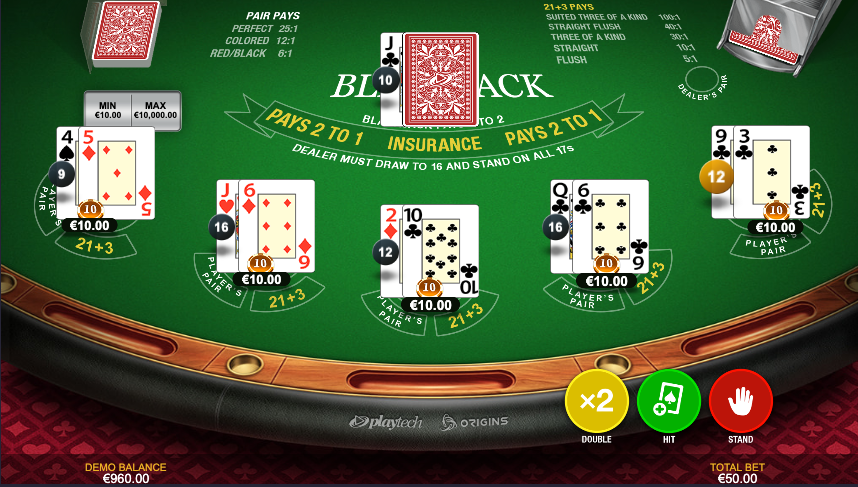
In this case, none of the hands can be split. The reason for this is easily explained using the blackjack split rule, which we’ll go through in the next section.
When Can You Split in Blackjack?
The blackjack split rule is very simple:
You can split cards if your first two cards are a pair with the same value.
Examples of cards that can be split are a pair of aces, a pair of 8s or a pair of 7s. Most casinos allow any pair of 10-value cards to be split, for example J-K or 10-Q, even though the cards don’t have the same rank.
However, some casinos only allow 10-value cards to be split if they have the same rank (for example, allowing a pair of jacks to be split, but not a king and a queen).
To signal that you want to split in a real-world casino, first place the same value of chips already staked next to your current chips, to double your stake.
Then, with your palm downwards, separate your index and middle fingers into a V-shape and place the fingertips of these fingers on the table.
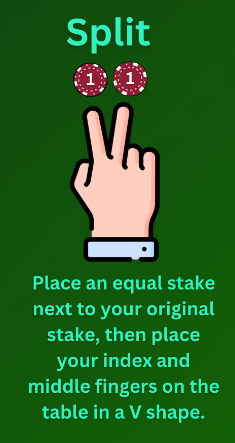
Splitting in online blackjack is even easier - if you’re allowed to split, there will be a ‘Split’ button that you can click.
The dealer will split the two cards by moving them side-by-side, making two hands, then deal another face-up card onto each card.
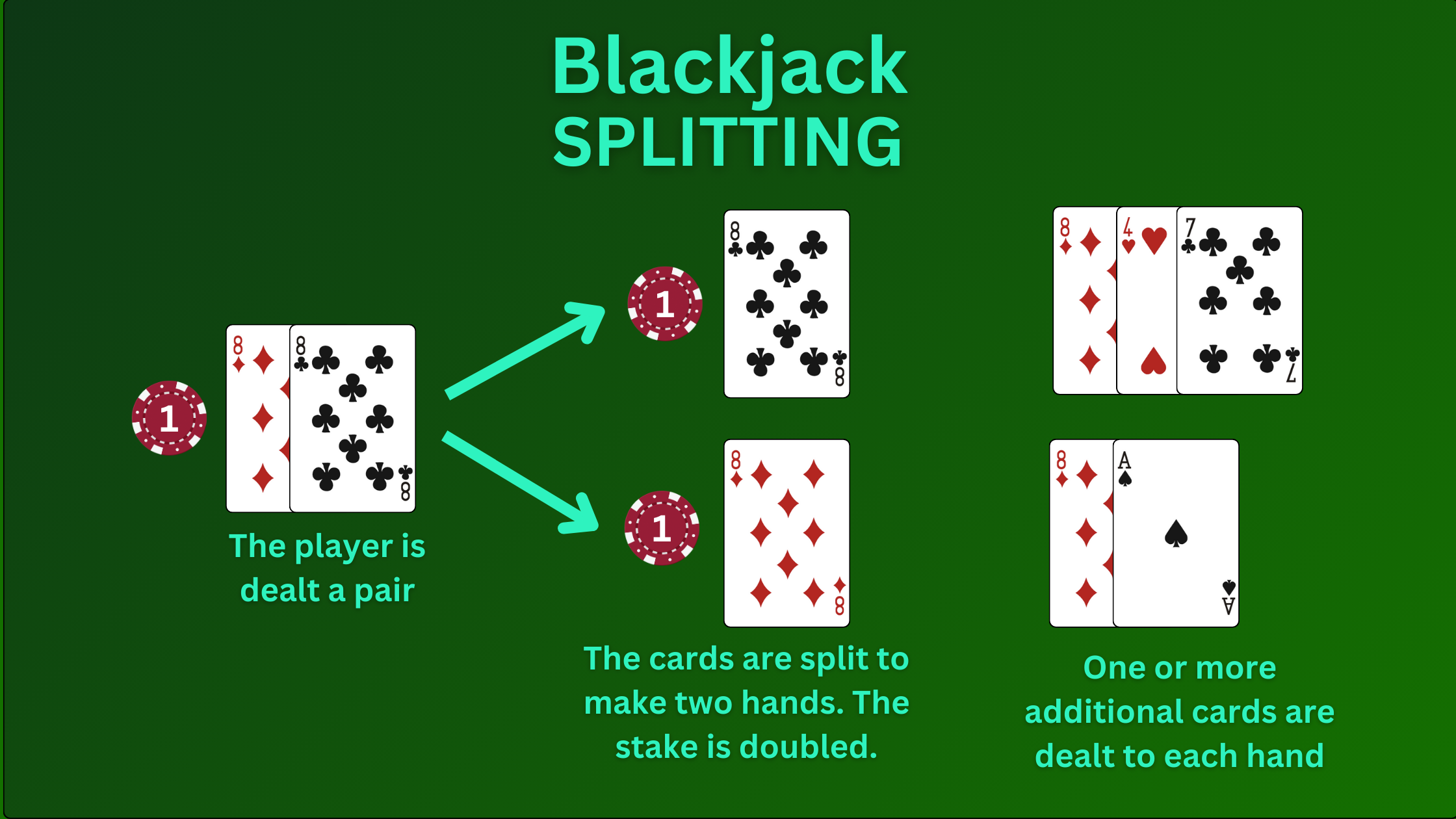
Unless the cards that you split were aces, you'll then be able to hit either of your hands and, depending on the rules of the game, in some cases, double or split again (known as re-splitting). Each of your split hands is treated as an individual hand.
What Can You Do After Splitting?
Once you have split your hand you’ll end up with two separate hands, which are played individually, one at a time.
If you’ve split aces, you’ll only be dealt one more card and won’t be able to double. If you’re dealt a 10-value card to your ace, it will normally count as 21 but not blackjack.
For any other value of cards split, you can stand, or hit as many times as you want to. You’ll normally be allowed to double after splitting.
Splitting More Than Once
With many blackjack variants, you’ll only be allowed to split your hand once, using the two cards initially dealt to you.
Some casinos and blackjack variants allow you to split more than once. As mentioned previously, this is known as re-splitting.
If this is the case, the house edge is reduced and you’ll get a higher Return To Player (RTP) for the game. This is the reason a lot of blackjack variants don’t allow re-splitting!
Blackjack variants that allow re-splitting usually limit this to splitting a maximum of three times, giving four hands in total.
The Effect of Rule Variations on RTP
Variations in blackjack rules affect the Return To Player (RTP) of the game.
You can see the effect of a range of rule variations on RTP at the excellent Wizard of Odds site here. All the variations mentioned that relate to splitting are listed in the table below.
The effect on the Return To Player from the rule variations are all relative to the following rules:
- Eight decks
- Dealer stands on soft 17
- Player may double on any first two cards
- Player can double after splitting
- Player may split to 4 hands
| Rule Variation | Effect on Return to Player |
| Ace and 10 after splitting aces is a blackjack (paying 3-2) | +0.21% |
| Player may draw to split aces | +0.19% |
| Player may double, double for less, or stand after splitting aces | +0.15% |
| Ace and 10 after splitting aces is a blackjack (paying 6-5) | +0.11% |
| Player may resplit aces | +0.08% |
| Player may double or stand after splitting aces | +0.08% |
| Player may not resplit | -0.10% |
| Player may not double after splitting | -0.14% |
| Player may not split aces | -0.18% |
| Player may not split | -0.57% |
| Player may not double nor split | -1.91% |
Re-splitting often isn’t allowed, particularly with online blackjack, so this reduces the RTP by 0.10% compared to the above rules.
To give an example of some fairly typical online blackjack rules, here are Premium Blackjack’s rules that relate to splitting:
- The player may not split a split hand (i.e. no re-splitting is allowed)
- Only one card is drawn to each Ace in a split hand
- The player may double once after splitting
- Doubling after split aces isn’t possible, since only one card is dealt to the split cards
- Ace and a 10-point card after a split are considered 21, and not Blackjack.
Premium Blackjack has an RTP of 99.58% even without allowing re-splits, assuming you stick rigidly to Basic Blackjack Strategy (more about this later).
This means that if the possibility of re-splitting was added to the game, it would add 0.10% to the RTP, giving a total RTP of 99.68%.
When Should You Split?
Blackjack theory has been studied for many years, leading to the development of optimum strategies for play.
Foremost amongst these is Basic Blackjack Strategy, which tells you exactly how to play, no matter what cards you and the dealer are dealt.
Basic Blackjack is covered extensively in the How To Play Blackjack Ultimate 2025 Guide. Here, we’ll just focus on when you should split.
If you just want to know when it’s best to split, feel free to skip to the ‘Basic Blackjack Strategy‘ section below, or use Outplayed’s excellent Blackjack Calculator, which does all the hard work for you.
There are a few basic principles to consider when deciding whether or not to split.
Aces and Eights
Blackjack rules differ between different casinos and different blackjack variants, but a key principle that applies regardless of these differences is “Always split aces and eights”.
If you look at the Basic Blackjack Strategy chart for pairs in the next section, you’ll see that if surrender is allowed, the dealer hits on soft 17, and you have a pair of 8s against a dealer’s ace, it’s better to surrender.
If you have a pair of aces and don’t split, your hand will be worth 2 or 12, both of which are poor hands. Splitting gives you two very strong hands worth either 1 or 11, partly as you now have a good chance of being dealt a 10 to end up with the maximum 21.
With a pair of 8s, your hand is a hard 16, one of the worst hands possible. It’s much better to split those 8s to get two hands with a value of 8, from which you have several ways to achieve a decent hand value.
In the world of card counting, there are a few occasions when not splitting aces or eights is theoretically marginally better. Stanford Wong details this in his 1975 book, Professional Blackjack.
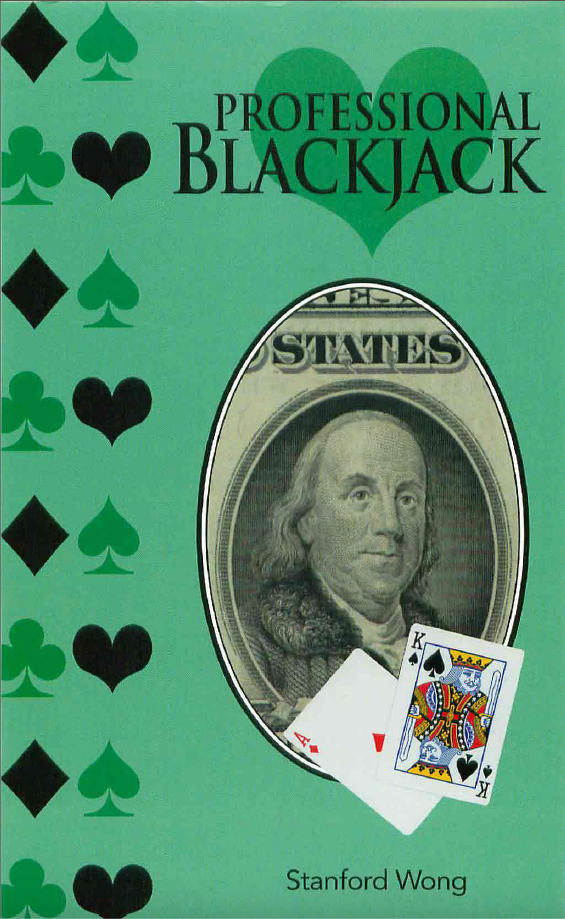
In practical terms, these situations don’t occur often enough to make a significant difference, so it’s likely that most card counters will stick to the “Always split aces and eights” rule.
To consider not splitting aces, the remaining deck would have to be so unfavourable to card counters (due to a count of -3 or lower) that they’d be better to leave the table completely.
Never Split 5s
This is a nice easy one which always applies, even to card counters - you should never split 5s.
A pair of 5s gives your hand a value of 10 points, which is a very strong hand and one of the best hands for a player to have in blackjack. You have a good chance of being dealt a ten to give you 20 points or, even better, an ace to give 21.
This is much better than splitting the pair to end up with two weak hands worth 5 points each.
Never Split 10s
When playing Basic Blackjack Strategy, you should never split 10s, since you already have a hand worth 20 points (the second highest points value possible), and you’re likely to end up with a worse hand if you split to get two hands worth 10 points each.
This is one where card counters will often break this basic rule since there are a few occasions when it’s better to split 10s rather than stand. Here are the most important two:
- If the true count is 4 or higher and the dealer has 6
- If the true count is 5 or higher and the dealer has 5
These are two of the most important blackjack deviations for card counters. Blackjack deviations involve changing your strategy from Basic Blackjack Strategy when the deck is favourable to you.
Renowned gaming mathematician, blackjack specialist, and member of the Blackjack Hall of Fame, Don Schelsinger, published his influential 1997 book Blackjack Attack - Playing the Pros’ Way.
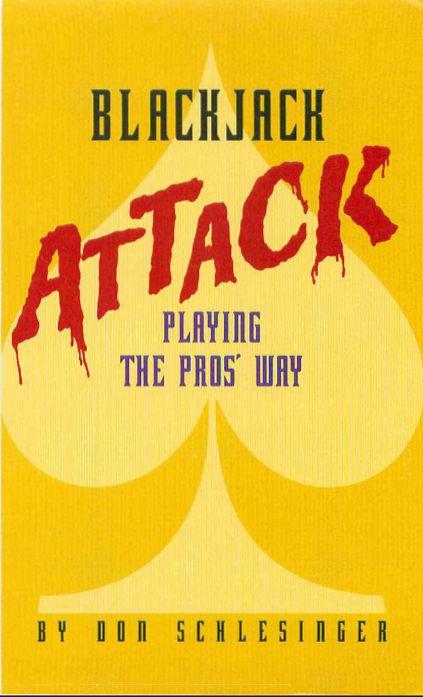
In it, he listed his ‘Illustrious 18’, the eighteen most important blackjack deviations for increasing your edge over the casino when card counting using the Hi-Lo system.
Here’s the full list of the ‘Illustrious 18’, which ranks the deviations from Basic Blackjack Strategy in terms of their impact on the house edge. The two deviations mentioned above for splitting 10s are ranked very highly in 4th and 5th place:
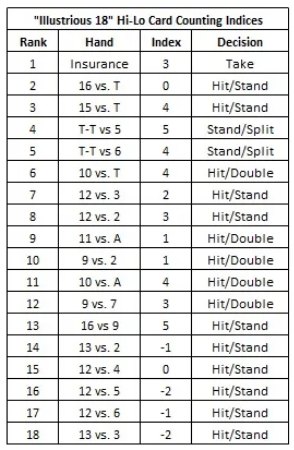
According to Don Schlesinger, the top 12 of these deviations account for more than 90% of all the gain that can be achieved by making changes to Basic Blackjack Strategy when card counting using the Hi-Lo System.
For completeness, these other deviations where it’s technically better to split 10s rather than stand are also mentioned in Stanford Wong’s book. However, they aren’t important enough to make the ‘Illustrious 18’ list:
- If the true count is 6 or higher and the dealer has 4
- If the true count is 8 or higher and the dealer has 3
Basic Blackjack Strategy
Only a very small proportion of blackjack players will ever get involved with card counting, which is difficult and takes lots of practice.
This means that, unless you’re doing a worthwhile casino offer involving blackjack, the casino will always have the edge.
Even so, you can minimise this house edge by following Basic Blackjack Strategy, which is the most effective strategy that doesn’t involve advanced methods like card counting.
There are various Blackjack Strategy charts, which you can find here. However, we’ll focus on the strategy for pairs here, so you can see when it’s best to split, stand, hit, double, or surrender.
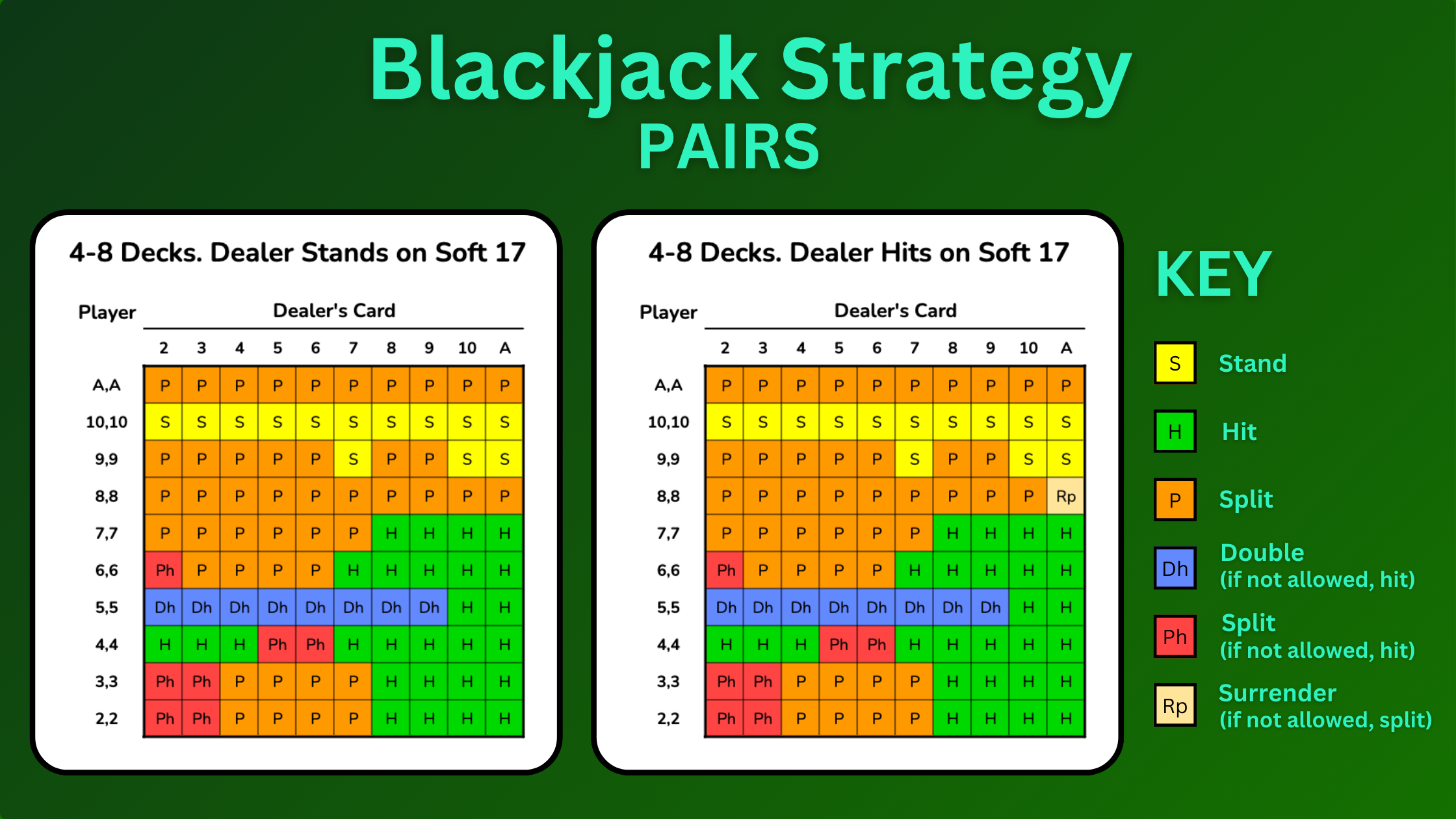
Although committing this strategy chart to memory will allow you to play the best possible game of blackjack quickly, if you’re playing blackjack online, whether computerised or in a live casino, it’s much easier to use Outplayed’s Blackjack Calculator, which is based on Basic Blackjack Strategy, instead.
Summary
Splitting in blackjack can be confusing at first, but isn’t difficult with a little practice. Here are some of the key facts to bear in mind about splitting.
- You can split if the first two cards you’re dealt have the same value
- Most casinos allow you to split any pair of 10-value cards (e.g. J-Q) even if they don’t have the same rank
- When you split, your stake is increased by the initial amount staked and the dealer separates your cards, placing them next to each other to form two new hands
- If you’ve split aces, you’ll normally only be dealt one more card, and can’t double
- If you’ve split any other value of cards, you can hit as many times as you want or stand. Most blackjack variants will also allow you to double
- Always split aces and 8s
- Never split 5s
- Never split 10s (unless you're a card counter)
Updated: 9 Sep 2025
The Author
Simon has helped thousands of members profit from Matched Betting using both his passion for writing and desire to understand how things work. He has used his mathematical and analytical skills to create several guides, calculators, betting and casino tools to make the process of Matched Betting easier for newcomers and experienced members alike.

